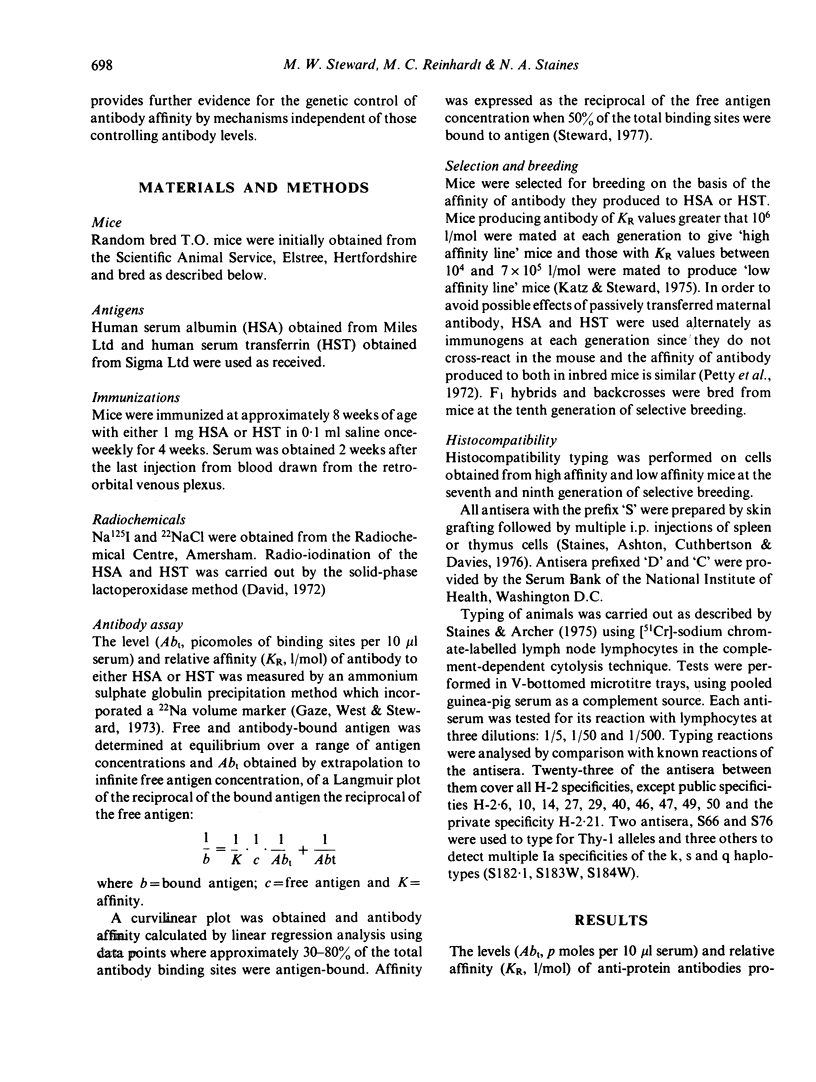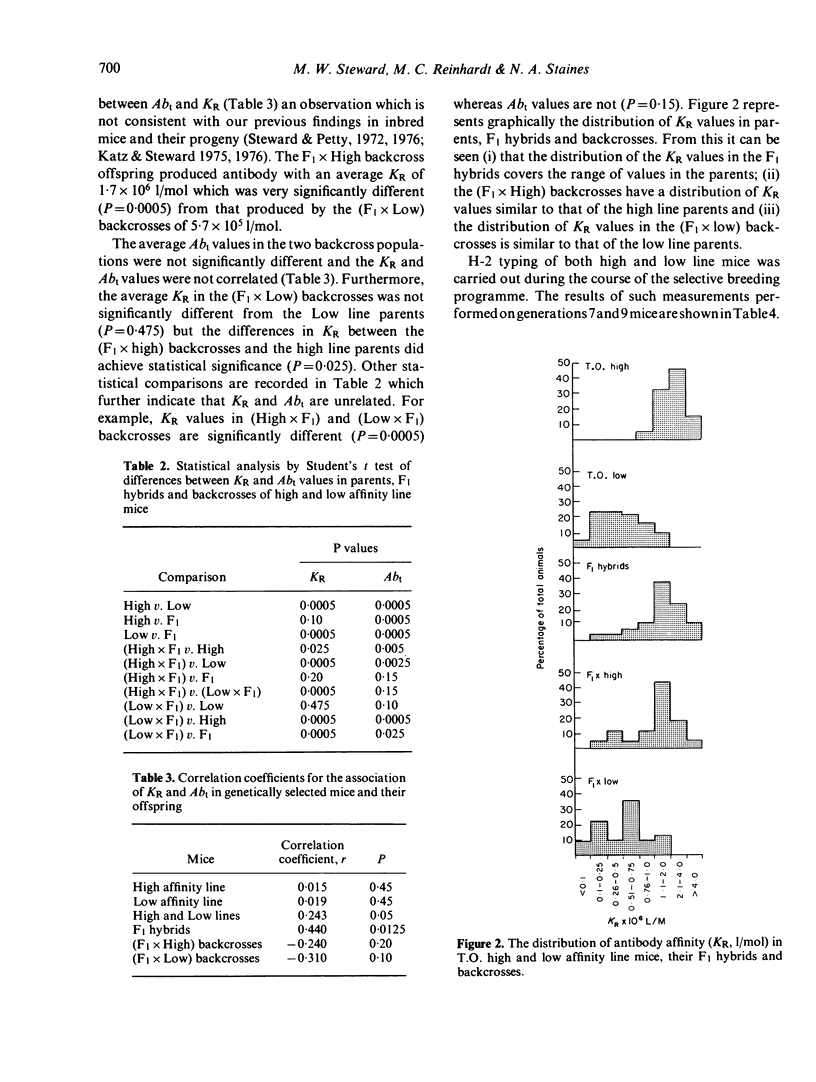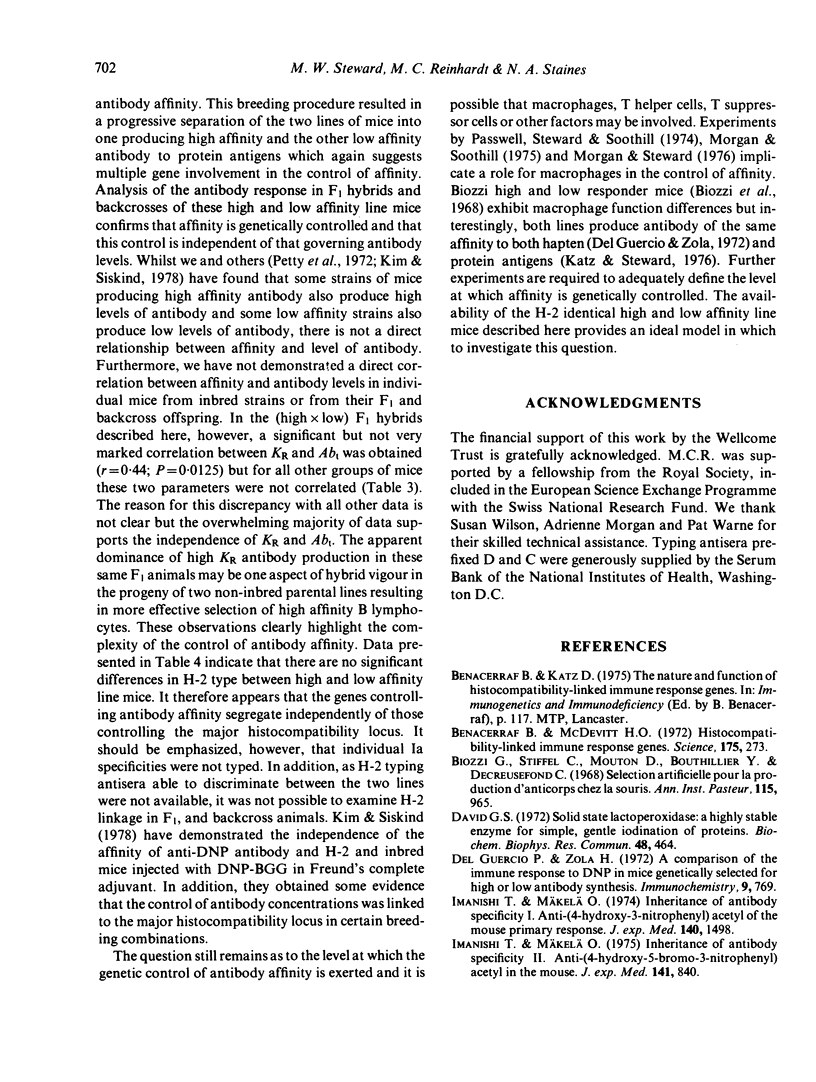Abstract
The genetic control of antibody affinity has been studied in mice selectively bred on the basis of the affinity of antibody they produce to protein antigens injected in saline. Two lines of mice have been obtained, one producing predominantly high and the other predominantly low affinity antibody. Breeding experiments have been performed with these two lines after ten generations of selection and the level and affinity of antibody to protein measured in parents, F1 hybrids and backcross offspring. The results indicate that antibody affinity is a genetically controlled parameter of the immune response and that this control is exerted independently of that controlling antibody levels. Furthermore, high and low affinity line mice have been typed for major histocompatibility complex antigens and the results show that the two lines are not significantly different. This therefore suggests that genes controlling antibody affinity are not linked to the major histocompatibility locus.
Full text
PDF






Selected References
These references are in PubMed. This may not be the complete list of references from this article.
- Benacerraf B., McDevitt H. O. Histocompatibility-linked immune response genes. Science. 1972 Jan 21;175(4019):273–279. doi: 10.1126/science.175.4019.273. [DOI] [PubMed] [Google Scholar]
- David G. S. Solid state lactoperoxidase: a highly stable enzyme for simple, gentle iodination of proteins. Biochem Biophys Res Commun. 1972 Jul 25;48(2):464–471. doi: 10.1016/s0006-291x(72)80074-3. [DOI] [PubMed] [Google Scholar]
- Del Guercio P., Zola H. A comparison of the immune response to DNP in mice genetically selected for high or low antibody synthesis. Immunochemistry. 1972 Aug;9(8):769–778. doi: 10.1016/0019-2791(72)90256-x. [DOI] [PubMed] [Google Scholar]
- Imanishi T., Makela O. Inheritance of antibody specificity. II. Anti-(4-hydroxy-5-bromo-3-nitrophenyl) acetyl in the mouse. J Exp Med. 1975 Apr 1;141(4):840–854. [PMC free article] [PubMed] [Google Scholar]
- Imanishi T., Mäkelä O. Inheritance of antibody specificity. I. Anti-(4-hydroxy-3-nitrophenyl)acetyl of the mouse primary response. J Exp Med. 1974 Dec 1;140(6):1498–1510. doi: 10.1084/jem.140.6.1498. [DOI] [PMC free article] [PubMed] [Google Scholar]
- Katz F. E., Steward M. W. Studies on the genetic control of antibody affinity: the independent control of antibody levels and affinity in Biozzi mice. J Immunol. 1976 Aug;117(2):477–479. [PubMed] [Google Scholar]
- Katz F. E., Steward M. W. The genetic control of antibody affinity in mice. Immunology. 1975 Sep;29(3):543–548. [PMC free article] [PubMed] [Google Scholar]
- Kim Y. T., Siskind G. W. Studies on the control of antibody synthesis. XII. Genetic influences on antibody affinity. Immunology. 1978 Apr;34(4):669–678. [PMC free article] [PubMed] [Google Scholar]
- McDevitt H. O., Benacerraf B. Genetic control of specific immune responses. Adv Immunol. 1969;11:31–74. doi: 10.1016/s0065-2776(08)60477-0. [DOI] [PubMed] [Google Scholar]
- Morgan A. G., Soothill J. F. Relationship between macrophage clearance of PVP and affinity of anti-protein antibody response in inbred mouse strains. Nature. 1975 Apr 24;254(5502):711–712. doi: 10.1038/254711a0. [DOI] [PubMed] [Google Scholar]
- Morgan A. G., Steward M. W. Macrophage clearance function and immune complex disease in New Zealand Black/White F1 hybrid mice. Clin Exp Immunol. 1976 Oct;26(1):133–136. [PMC free article] [PubMed] [Google Scholar]
- Passwell J. H., Steward M. W., Soothill J. F. Inter-mouse strain differences in macrophage function and its relationship to antibody responses. Clin Exp Immunol. 1974 May;17(1):159–167. [PMC free article] [PubMed] [Google Scholar]
- Petty R. E., Steward M. W., Soothill J. F. The heterogeneity of antibody affinity in inbred mice and its possible immunopathologic significance. Clin Exp Immunol. 1972 Oct;12(2):231–241. [PMC free article] [PubMed] [Google Scholar]
- Ruscetti S. K., Kunz H. W., Gill T. J., 3rd The genetic control of antibody binding constants and specificities in inbred rats. J Immunol. 1974 Nov;113(5):1468–1476. [PubMed] [Google Scholar]
- Soothill J. F., Steward M. W. The immunopathological significance of the heterogeneity of antibody affinity. Clin Exp Immunol. 1971 Aug;9(2):193–199. [PMC free article] [PubMed] [Google Scholar]
- Staines N. A., Archer J. R. Expression of major histocompatibility complex antigens on different cell types. Isr J Med Sci. 1975 Dec;11(12):1319–1330. [PubMed] [Google Scholar]
- Steward M. W., Petty R. E. Evidence for the genetic control of antibody affinity from breeding studies with inbred mouse strains producing high and low affinity antibody. Immunology. 1976 Jun;30(6):789–797. [PMC free article] [PubMed] [Google Scholar]
- Steward M. W., Petty R. E. The use of ammonium sulphate globulin precipitation for determination of affinity of anti-protein antibodies in mouse serum. Immunology. 1972 May;22(5):747–756. [PMC free article] [PubMed] [Google Scholar]


